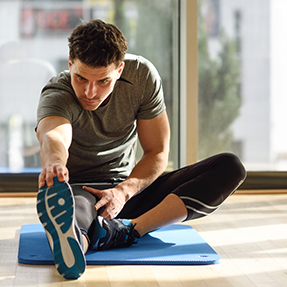
Kegel exercises – Strengthen your pelvic floor
Even though there might be no question of urinary incontinence, the years keep taking their toll on you. If you have reached a certain age, your control over your bladder is no longer what it used to be in your teenage years. Nonetheless, there’s something you can do at home, something that even doctors are endorsing: Kegel exercises.
Kegel exercises are a type of exercise that strengthens the pelvic floor. They are named after Dr. Arnold Kegel, who first introduced them to the public in 1948.
If you want to know more about Kegel exercises, how and if they work, keep reading. Learn if this type of training is for you, what the benefits are, and more.

What are Kegel exercises?
Kegel exercises are a type of exercise that can help men strengthen their pelvic floor muscles. They involve contracting and releasing the muscles around the genitals, bladder, and rectum. This helps to improve bladder control but also sexual function in men.
A pelvic floor is a group of muscles at the base of your abdomen that supports your bladder, bowel, and rectum. It also helps to control urination and bowel movements. Kegel exercises are designed to strengthen these muscles so they work better for you in everyday life.
Think of the pelvic floor as an extremely elastic film. In the beginning, it is extremely responsive to your commands. However, in time, it starts becoming loose and can no longer respond to commands in the same millisecond. By practicing Kegel exercises, the pelvic floor can regain some of its lost elasticity.
Who should do Kegels?
Although mostly targeted at women, Kegel exercises are beneficial for men as well. Therefore, both sexes should consider this type of practice when:
- Men and women want to prevent urinary incontinence;
- Women want to recover their pelvic floor elasticity after pregnancy, childbirth, weight gain, or after a certain age;
- Women leak a few drops of urine after sneezing, coughing, or laughing;
- Women still feel the urge to urinate, even after just exiting the bathroom;
- Men want to improve incontinence;
- Men are trying to get prostate pain relief after a prostatitis or benign prostatic hyperplasia diagnosis;
- Both women and men want to increase their sexual pleasure and refine their orgasm sensation.
Benefits of strengthening your pelvic floor
The pelvic floor muscles are often neglected in our daily routines. This is because they are not visible like other muscles in the body. However, it is important to strengthen them as they support important muscles and organs in our body.
Pelvic floor exercises can help with incontinence, constipation, and even sexual dysfunction. This training can also help with reducing lower back pain. While it’s not a standalone cure for this type of pain, Kegels can rewire practitioners to the correct movement patterns that involve the lower back.
Kegels can also save you from awkward accidents when gas is unintentionally released in public spaces. You’ll also regain better control over your bladder and bowels.
How to do Kegel exercises
Kegel exercises are possibly the easiest type of muscle training there is. But first, you need a preliminary understanding of your pelvic floor muscles. Learn where they are located, how it feels to have them activated, and how to take control over them.
How women can find their pelvic floor muscles
At the moment, you’re like that person that marvels at someone who can control their ear muscles enough to move them front and back. You’re wondering how they can pull such a stunt. In actuality, it’s about becoming aware of those muscles and gaining control over them. The same goes for your pelvic floor muscles.
In order to do Kegels the right way, women should first identify their pelvic floor muscles. There are several ways to achieve this:
- Introduce a clean finger to a shallow depth inside the vagina and contract the muscles around your finger – the muscles you are feeling are part of the pelvic floor;
- Sit on the toilet and release your flow, and then stop midway. The muscles you are using to execute this action are also those that make up the pelvic floor.
Do any of these exercises or both of them, but you shouldn’t repeat them after you’ve identified your pelvic floor muscles. Otherwise, you can contract a urinary tract infection or it may lead to other health complications.
How men can find their pelvic floor muscles
There might be confusion as to where the pelvic floor muscles are located in men as well. But there are useful tricks to get the right group of muscles for men as well:
- Insert a clean finger into the rectum and try to squeeze the muscles around the finger. Try to disconnect the muscles of your abdomen, buttocks, or thighs from engaging in this procedure. Those who remain active are your group of pelvic floor muscles.
- Activate the muscles that keep you from releasing gas. These are your pelvic floor muscles.
- Stop urination midstream and identify the muscles that are helping you succeed in this endeavor.
You shouldn’t repeat any of these exercises once you’ve identified the muscles in question. However, if none of these practices helped you locate your pelvic floor muscles, then specialists can guide you through biofeedback training and electrical stimulation.
How to start your Kegel exercises
Now that you know which group of muscles you should activate, you are ready to start your Kegel exercises. Repeat the following routine three times a day:
- Begin when your bladder is empty;
- At your first experience with Kegels, it is recommended to start from a sitting position or lie down on your bed or couch;
- Tighten your pelvic floor muscles and hold them tight for 3 to 5 seconds;
- Relax the muscles, and wait in this idle position for another 3 to 5 seconds;
- Repeat this routine ten times to complete one session of Kegel exercises.
It is important to clear your mind of any worries during these exercises so as to unwind your entire body. Another important aspect is to focus only on your pelvic floor muscles. If your stomach, thigh, buttock, or chest muscles are activated during your Kegels, then the execution is faulty.
Signs of pelvic floor strength improvement
The first results will start showing up after 4 to 6 weeks of practicing Kegel exercises three times a day. The first signs will appear in the form of improvement in urinary incontinence. If you are not afflicted by any condition, then you are about to gain better control over your muscles, which is going to heighten bladder control and sexual pleasure.
Moreover, at the end of a couple of months of practice, you’ll be able to keep your muscles tightened from 5 to 10 seconds. This improvement is going to lead to stronger and more elastic muscles.
Causes of pelvic organ prolapse
When you suffer from pelvic organ prolapse, it means that your pelvic organs (bladder, uterus, small bowel, and rectum), are weakened. When these organs start dropping down to the vagina, a case of pelvic organ prolapse ensues.
Almost 3% of women have pelvic organ prolapse in the U.S. There’s a variety of factors that are causing this condition:
- Pregnancy;
- Childbirth;
- Obesity;
- Constipation;
- Respiratory problems that developed into a chronic cough;
- Cancers of pelvic organs;
- Hysterectomy;
- The genetic code.
Generally, this condition manifests itself through the following symptoms:
- Vaginal bleeding;
- Lower back pain;
- A sensation of pressure in the pelvic area;
- Pain during intercourse;
- Urine leakage;
- Frequent urge to urinate.
Among mechanical and surgical treatments, doctors recommend individuals with pelvic organ prolapse to practise Kegel exercises. They strengthen the pelvic muscles and help accelerate the healing process.
Are Kegels for both men and women?
Yes, Kegel exercises are for both men and women. Even though Kegels have been for far too long recommended for women, men can also put Kegel exercises to good use, especially if they are committed to curbing the side-effects of aging. Kegels can help to prevent or treat urinary incontinence and improve sexual function in both men and women.
